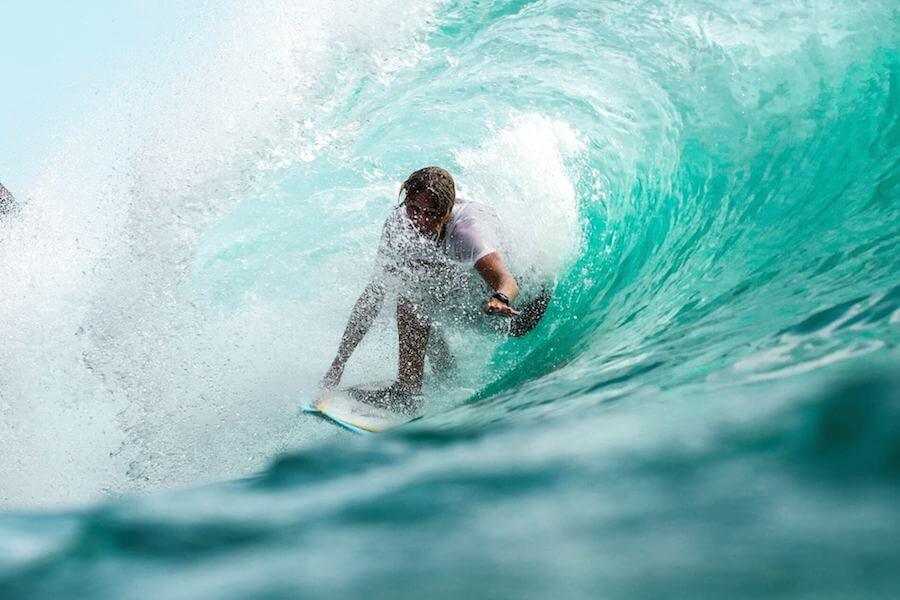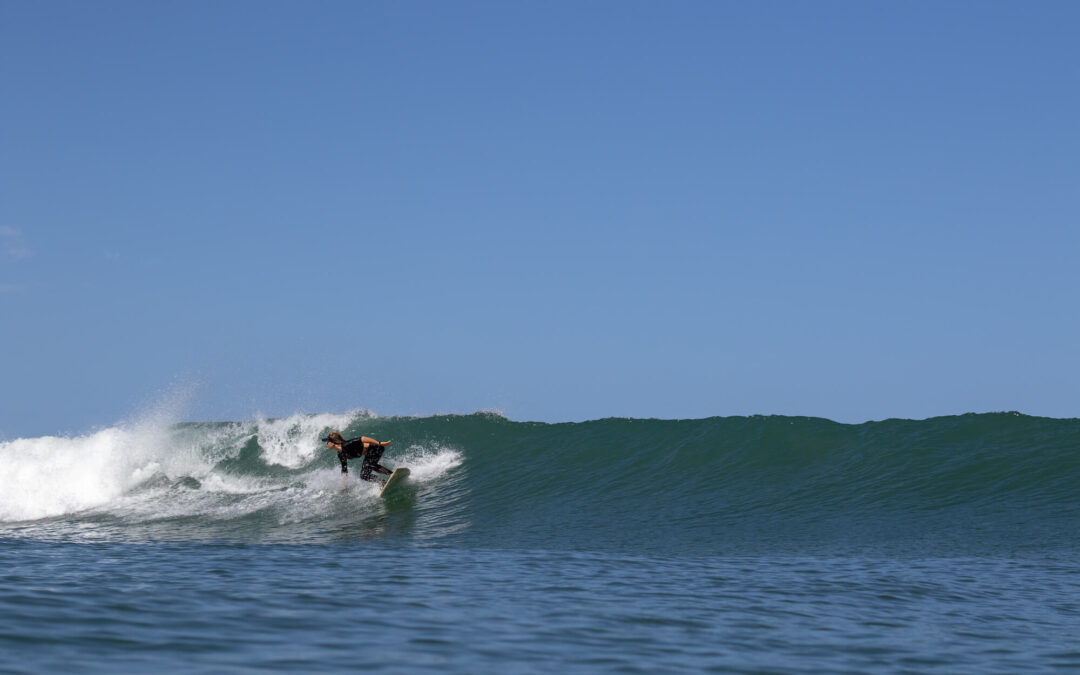In today’s ever-evolving world of surfing, the pursuit of excellence pushes boundaries like never before. We’re always looking to be bigger, better, stronger, faster, more powerful and more critical. The once-impossible maneuvers now demanded of a “good surfer” exert tremendous forces on the body. Over the past decade, the physical demands placed on surfers have skyrocketed. Achieving peak surf performance now requires specialised training to prepare the body for the repetitive and extreme movements that have become routine in the sport. As surfers, we’re not just athletes; we’re pioneers navigating the ever-changing landscape of wave riding. Read on to explore how prioritising our human movement before our surfer movement can elevate our performance and longevity in the water.
Surfers who have become adults all over the world are naturally inclined to want to surf bigger waves, try airs, get vertical and get barrelled. These kinds of extreme feats, reminiscent of skateboarding and snowboarding, demand impeccable timing, agility, coordination, and robust physicality. The higher risk and greater probability of injuries mean that the whole surfing game has ramped up quite a notch since the “Endless Summer” days. Thus, preparing and nurturing the body to maintain surfers’ fitness, strength, and suppleness amidst these added demands are indispensable for enhancing surf performance and longevity.
Surfing-Related Imbalances that Arise:
- When standing on our board, our hips rotate towards our back foot, resulting in imbalanced loading through the spine, hips, knees, and ankles over time.
- Increased loading occurs on the inside part of our back leg ankle and knee, potentially leading to ankle/knee pain or injuries (right knee/ankle for natural footers and left knee/ankle for goofy footers).
- Hip imbalances generate tension, affecting core muscle stability, which impacts surfing performance and overall physical activities.
- For natural footers, increased stress is placed on the right shoulder (left shoulder for goofy), reducing shoulder flexibility, coordination, and strength.
- Shortening of muscles in the neck, chest, lower back, hip flexors, and shoulder (including internal rotators, deltoids, teres, triceps, and lats) restricts normal range of motion. This compromises shoulder function holistically, leading to compensations in other areas of the body.
But there is hope! I recently returned from a two-month surfing adventure, fortunate enough to catch waves almost daily for 1.5 to 5 hours. Surfing, being such a significant energy expenditure, often leaves little desire or energy for additional physical training. However, intuitively, we recognize the importance of maintaining suppleness and strength, especially in areas where surfing neglects muscle development. This approach not only enhances surfing performance today but also for years to come. I diligently adhered to my daily mobility routine (not yoga), occasionally incorporating bodyweight strengthening exercises to address these neglected areas.
Try out the following 5-Exercise Surf Routine to incorporate mobility and strength exercises that will enhance your movements both in and out of the water:
Exercise Technique Recommendations
1.Single Leg Hip Bridge (foot on bench / couch / step) X 10 reps per side.
This exercise will strengthen your glutes and hamstrings while enhancing pelvic stability and strength. Performing it one leg at a time enables you to identify any imbalances in strength, stability, or mobility between your left and right sides. Elevating your foot will intensify the exercise as it increases the range of motion in your hips, thereby enhancing the strengthening effect.
2. Prone Overhead Shoulder Hovers X 10 inward and 10 outward.
Surfers devote considerable time to paddling, which heavily engages muscles responsible for shoulder internal rotation and downward pulling. This exercise focuses on strengthening the opposite actions—controlled upward lifting and shoulder external rotation. Consequently, long-time surfers often struggle with this movement due to weakness and limited range. To increase difficulty, raise your arms higher, incorporate light weights, or increase repetitions. This exercise targets the middle and lower trapezius muscles, enhancing overhead shoulder mobility and strength.
3. Lower Abdominal Strict Deadbugs X 6-10 reps per side.
By placing a Yoga Block between your same-side thigh and forearm and squeezing it tightly, it’s nearly impossible to cheat the movement and strain your lower back excessively. Squashing the Yoga Block ensures a strict engagement of your abdominals. Strengthening your lower abdominals is crucial for pelvic stability, maintaining lower spine health, and enhancing core strength.
4. Thoracic Rotation Active Holds X 5 per side of 5-10 active holds.
This movement is beneficial for improving mobility in your upper back (thoracic spine) rotation and flexibility in your inner thighs. By extending your leg to the side and maintaining level hips, you effectively restrict hip rotation. Similarly, by keeping your spine straight and bending forward from your hips, you prevent rotation in your lower spine.
5. Shoulder Clocks X 5-10 reps per side.
This is my favorite shoulder exercise of all time. It’s an active mobility exercise that combines multi-angle, multi-directional shoulder stretching with strengthening. By ensuring your torso remains strictly facing the side and maintaining fingertip contact with the floor, you can maximize shoulder movement. If your shoulder mobility is limited, you can regress the exercise by allowing your torso to rotate toward the sky while keeping your fingertips in contact with the floor.

Surfing itself is the ultimate training for surfing. Gym workouts need not replicate surfing maneuvers; the water is where perfect practice occurs. Optimise gym time by addressing mobility and strength deficits, training diverse movements, varying reps, sets, and rest periods, rotating exercises, and keeping workouts engaging and challenging. Prioritise training as an athletic human first and a surfer second. Focusing solely on surf-specific athleticism may exacerbate imbalances caused by surfing, compromising long-term performance and risking time away from the water.
Surf training should align with the sport’s demands for optimal results. This doesn’t necessitate mimicking surfing movements; rather, it entails developing hip strength, mobility, thoracic rotation, shoulder mobility, pulling power, agility, endurance, and quick reaction times. While strength training or running may seem like straightforward methods to enhance surfing fitness, they can inadvertently lead to slower athletes with muscular imbalances, decreased energy levels, and limited surf performance.
By employing surf training methods utilised by professional coaches to train their athletes and by understanding how surfing uniquely challenges the human body, surfers can effectively leverage surf training and surfing exercises.
Whatever your level of surfing or training background is, check out Surf Strength & Conditioning for a plethora of mobility, bodyweight strength, lifting, sports rehab and optimal posture exercises to keep you surfing better for longer.
